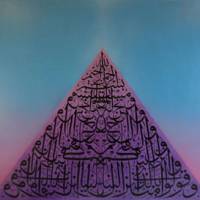Calligraphy has always been popular in Japan, but some people here are now attracted to an imported, yet equally profound, form of the traditional art: Arabic calligraphy.
Around 70 works by Japanese students of Arabic calligraphy will adorn the walls of Kanack Hall in Yokohama from Oct. 6 till Oct. 11 for the exhibition "Sabaku no Bara" ("Desert Roses"). Most of the pieces feature quotes from the Quran, but others are from Arabic proverbs and citations from Hadith, which are narrations of the words of Prophet Muhammad, said Koichi Yamaoka, secretary general of the Japan Arabic Calligraphy Association.
Visitors can also marvel at the works of Kouichi Honda, the pioneering Japanese master of Arabic calligraphy who has contributed greatly to the growing popularity of the art in Japan. Honda — some of whose works were put in the permanent collection of the British Museum in London in 2006 — has a reputation for combining calligraphy with a unique use of nuanced colors in the background.
But do visitors need to be immersed in the Islamic tradition and the Arabic language to appreciate this 1,400-year-old art? Not necessary, says Yamaoka, who teaches several of the dozen courses held at continuing education centers across Japan. "Many people look at Arabic calligraphy like they do paintings," Yamaoka says, noting that people who can't read Arabic can enjoy the art, which features lines that curve dramatically and vary in their thickness. "The letters (in Arabic calligraphy) are also attractive from a design point of view."
"Sabaku no Bara" runs Oct. 6-11 at Gallery A of Kanack Hall (1-10-1 Higashi-Kanagawa, Kanagawa Ward, Yokohama). Admission is free. The hall is a 1-minute walk from JR Higashi-Kanagawa Station or Nakakido Station on the Keihin Kyuko Line. For more information, call (045) 900-1012 or visit www.jaca2006.org/japan-arabic-calligraphy-association.

















With your current subscription plan you can comment on stories. However, before writing your first comment, please create a display name in the Profile section of your subscriber account page.